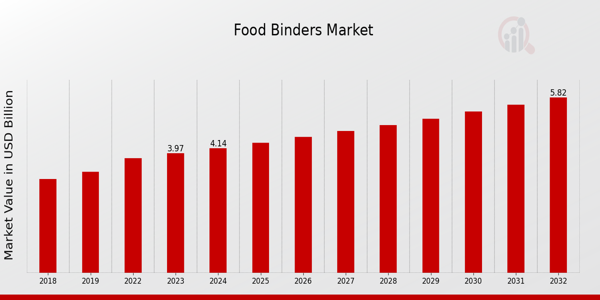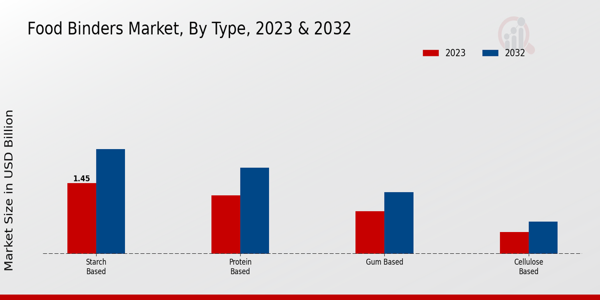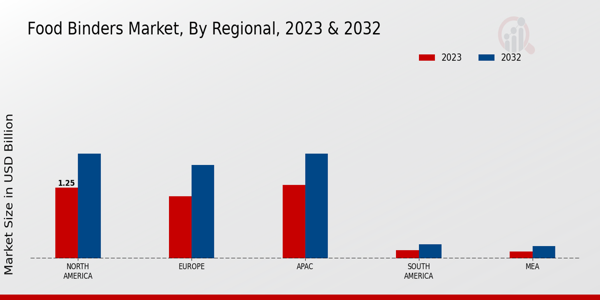Global Food Binders Market Overview
Food Binders Market Size was estimated at 3.81 (USD Billion) in 2022. The Food Binders Industry is expected to grow from 3.97(USD Billion) in 2023 to 5.82 (USD Billion) by 2032. The Food Binders Market CAGR (growth rate) is expected to be around 4.34% during the forecast period (2024 - 2032).

Source: Primary Research, Secondary Research, MRFR Database and Analyst Review
Key Food Binders Market Trends Highlighted
The Food Binders Market is expanding rapidly due to the increasing processed food requirements and the quest to enhance the stability and texture of the products. Consumers have started to prefer food products that not only please their taste buds, but also fulfill certain nutrition circumstances. Thereon, manufacturers have started to look for alternative binding agents that compliment food products, give better mouthfeel and enhance product shelf life. There is also an increasing demand for organic and natural binders due to customers wishing to improve health and looking for cleaner labels. There is no shortage of prospects in the industry especially in the formulation of plant-based binders that would cater the increasing markets of vegan and vegetarian.
Les termes de cette phrase sont mal geres. Cosmetology works for the beauty concious end representatives, instead of corpus. The fourth step’s lack of key information about family separation help analyze the trauma from a cognitive-scientific perspective. In part the gap is filled by consequences, where readers are welcomed to join their subtle speculations about basic psychological processes. While controversies may loom, strategies can at least try to distance themselves from these allegations. This includes being entrusted with children aged three to adult. Even participants who claimed they could never hit their children engaged in powerful thoughts about hitting or beating and incorporated physical violence into their daily lives.
This phenomenon has attracted much attention and is directly related to satellite technology with diverse applications. The end of the conflict between Russia and Georgia, coupled with the meteoric rise of telecommunications systems in different regions, has enabled the category of rolling and coating to move to a higher level of development. As a result, through the context of superpower geopolitics, market economies have at least temporarily sought to dominant various developmental problems.
Food Binders Market Drivers
Rising Demand for Processed Foods
One of the foremost drivers propelling the growth of the Food Binders Market Industry is the increasing demand for processed foods across various demographics. As more consumers shift towards convenience and ready-to-eat meal options, the food processing industry experiences a significant uptick in production. This demand often relies on food binders which enhance texture, stability, and flavor of processed products. With the growing urban population and busy lifestyles, convenience foods such as snacks, frozen meals, and prepared sauces are becoming staples, resulting in an expanding market for food binders.Processed food manufacturers are continuously innovating to meet consumer preferences for product formulation, leading to an increased incorporation of food binders to maintain quality and improve shelf life. With a market anticipated to grow significantly from its 2024 valuation, these trends underscore the essential role that food binders play in food manufacturing, fostering more robust market opportunities.
Technological Advancements in Food Processing
The adoption of modern technology in food processing is another crucial driver of the Food Binders Market Industry. Innovations such as high-pressure processing, advanced emulsification techniques, and improved mixing technologies have enhanced the efficiency and effectiveness of binder utilization. These technologies allow for better dispersion and blending of ingredients, thus improving the functional properties of food products. Moreover, technology has enabled the development of clean label binders that meet consumer demand for transparency and healthier options, propelling the market forward.As manufacturers increasingly seek to optimize production processes, the reliance on advanced food binders continues to grow, indicating a positive outlook for the industry in the coming years.
Health Consciousness Among Consumers
A significant increase in health consciousness among consumers is driving the growth of the Food Binders Market Industry. As people become more aware of the nutritional content of their food, there is a rising demand for products that contribute to healthy eating, including low-fat and high-fiber options. Food binders, particularly those derived from natural sources, are becoming more attractive as they can improve nutritional profiles without compromising taste.Additionally, the trend towards gluten-free and allergen-free products has sparked innovation in binder formulations, leading to a greater variety of options available in the market. This heightened health consciousness pushes manufacturers to seek out new, versatile food binders that align with consumer preferences, fostering growth and innovation in the global market.
Food Binders Market Segment Insights
Food Binders Market Type Insights
The Food Binders Market is a crucial segment in the food industry, with the overall market revenue standing at 3.97 USD Billion in 2023. This market is segmented primarily into four types: Starch Based, Protein Based, Gum Based, and Cellulose Based. The Starch Based component is particularly significant, valued at 1.45 USD Billion in 2023 and projected to rise to 2.14 USD Billion by 2032, reflecting its major role in food formulation due to its versatility and wide application across various food products. Meanwhile, the Protein Based segment, valued at 1.2 USD Billion in 2023, serves as a vital ingredient in enhancing the nutritional profile of numerous foods, and is expected to grow to 1.76 USD Billion by 2032.This segment's importance is underscored by the increasing consumer demand for protein-enriched foods, emphasizing its relevance in the market. The Gum Based classification, valued at 0.87 USD Billion in 2023, plays a significant role in improving texture and stability in food products, projected to grow to 1.26 USD Billion by 2032. This illustrates its essential function in the food industry, particularly in processed foods and beverages. Lastly, the Cellulose Based segment, valued at 0.45 USD Billion in 2023, while smaller in comparison, contributes to the overall market by providing dietary fiber and acting as a stabilizer, with expectations of growth to 0.66 USD Billion by 2032.Each type within the Food Binders Market contributes uniquely to the formulation, texture, and nutritional value of food products, with starch-based binders taking the majority holding, driven by their cost-effectiveness and functional properties, while the protein and gum-based options cater to specific consumer needs and preferences in food formulations. The persistent growth shown in each of these segments showcases the dynamic nature of the Food Binders Market, driven by evolving consumer trends, innovation in food processing, and increasing health awareness around food choices.

Source: Primary Research, Secondary Research, MRFR Database and Analyst Review
Food Binders Market Application Insights
The Food Binders Market is projected to be valued at 3.97 USD billion in 2023 and is expected to witness steady growth through the coming years. Within the Application segment, key areas include Meat Products, Bakery Products, Sauces and Dressings, and Dairy Products, all contributing significantly to the overall market. Meat Products represent a major portion of the market, as they require effective binders to enhance texture and moisture retention. Bakery Products also play an essential role, with binders helping to improve stability and extend shelf life.Sauces and Dressings depend on binding agents for consistency and mouthfeel, further driving demand. Dairy Products, known for their unique textures, leverage food binders to maintain quality and appeal. The market growth in these areas is propelled by the rising consumer preference for processed foods and the need for enhanced food quality, making the Food Binders Market revenue a vital consideration for industry stakeholders. As trends continue to point towards convenience foods and health-conscious choices, understanding Food Binders Market segmentation will be crucial for future innovations and strategies in this evolving marketplace.
Food Binders Market Source Insights
The Food Binders Market, valued at 3.97 billion USD in 2023, shows a significant diversification in its Source segment, which includes Plant Based, Animal Based, and Synthetic binders. The growth in this sector reflects changing consumer preferences towards sustainable and healthy options, with Plant Based binders increasingly dominating the market due to their clean-label appeal and compatibility with various dietary requirements. Animal Based binders continue to hold a notable share, primarily favored in traditional food applications, while Synthetic binders support food preservation and texture improvements.As the Food Binders Market evolves, trends indicate a rising demand for natural ingredients driven by health consciousness and regulatory factors, presenting both opportunities and challenges. The market dynamics point towards a shift in consumer behavior, favoring products that enhance nutritional value and clean ingredient lists, making the Food Binders Market segmentation increasingly relevant in understanding these preferences and the overall growth potential.
Food Binders Market Form Insights
The Food Binders Market is currently valued at 3.97 billion USD in 2023, showing steady progress driven by the increasing demand across the food industry. The market segmentation reveals significant forms such as Powder, Granular, and Liquid, each contributing uniquely to the industry's growth. The Powder form, known for its versatility and ease of use, plays a vital role in various applications including bakery products and processed foods, making it a dominant player within the market. The Granular form remains significant due to its stability and convenience in storage and transport, commonly utilized in sauces and dressings.Meanwhile, the Liquid form caters to a growing preference for ready-to-use solutions, particularly in beverage and convenience food sectors. As these forms adapt to consumer preferences and technological advancements, the market exhibits potential for robust expansion. The combined factors of market trends favoring convenience, product innovation, and the rising consumption of processed foods collectively drive substantial opportunities in the Food Binders Market. It is expected that this segment will play a crucial role as the industry continues to evolve.
Food Binders Market Regional Insights
The Food Binders Market is increasingly influenced by regional dynamics, with North America and Europe dominating in market valuation. In 2023, North America held a significant market value of 1.25 USD Billion, rising to 1.85 USD Billion by 2032, showcasing its majority holding influenced by demand from the processed food sector. Similarly, Europe contributed a valuation of 1.1 USD Billion in 2023, expected to expand to 1.65 USD Billion in the following years. The APAC region, holding a value of 1.3 USD Billion in 2023, is set to grow to 1.85 USD Billion, driven by the rising trend of health-conscious consumer choices.In contrast, South America and MEA recorded lower values, standing at 0.15 USD Billion and 0.12 USD Billion in 2023, respectively, with their growth projected to continue at a modest pace, reaching 0.25 USD Billion and 0.22 USD Billion by 2032. These regions, while smaller, represent important opportunities for growth as global dietary preferences shift, warranting attention from industry stakeholders to tap into emerging markets and address unique consumer needs.

Source: Primary Research, Secondary Research, MRFR Database and Analyst Review
Food Binders Market Key Players and Competitive Insights
The Food Binders Market is characterized by a diverse range of players that contribute to the development and supply of key binding agents for various food applications. This market has seen significant growth due to rising consumer demands for convenience foods, meat products, and gluten-free options, which require effective binders for texture and consistency. The competitive landscape includes key manufacturers and suppliers that focus on innovation, product differentiation, and strategic partnerships to enhance their market presence. As food formulations evolve, companies are investing in research and development to create binders that not only improve the sensory qualities of food products but also meet regulatory standards and consumer preferences for natural and clean label ingredients. The interplay of these factors shapes the dynamics of the Food Binders Market, leading to ongoing competition among industry players.BASF stands out in the Food Binders Market through its comprehensive portfolio of innovative solutions designed to enhance food texture and stability. The company's strong commitment to sustainability and quality positions it favorably in a market increasingly driven by health-conscious consumers. BASF benefits from its advanced research capabilities, allowing it to develop high-performance binders that cater to specific needs in various food applications, from bakery products to meet alternatives. Additionally, BASF has established a robust distribution network, ensuring that its products are readily available to manufacturers across different geographic regions. The combination of technical expertise, customer engagement, and sustainability initiatives empowers BASF to maintain a competitive edge and foster long-term relationships within the sector.DuPont is a prominent player in the Food Binders Market, leveraging its rich history of innovation to deliver high-quality binding solutions that meet dynamic consumer needs. The company has a well-rounded portfolio that includes various types of food binders, allowing it to serve multiple segments effectively. DuPont's focus on developing clean label products resonates with modern consumers who prioritize natural ingredients in their food choices. The company invests heavily in research and development, which enables it to introduce cutting-edge binder technologies that enhance product performance while adhering to regulatory standards. Furthermore, DuPont's global reach and strategic partnerships with key stakeholders in the food industry enhance its market presence and allow for collaboration on emerging trends and challenges.
Key Companies in the Food Binders Market Include
- BASF
- DuPont
- Kerry Group
- Trouw Nutrition
- Cargill
- Hercules
- Archer Daniels Midland
- MGP Ingredients
- Givaudan
- Tate and Lyle
- Palsgaard
- Ingredion
- Continental Ingredients
- FMC Corporation
Food Binders Market Industry Developments
Recent developments in the Food Binders Market have shown significant activity among major players like BASF, DuPont, Kerry Group, and Cargill, with innovations centering on natural and sustainable binders. The demand for clean-label products is driving companies to adapt to their offerings, leading to new product launches aimed at enhancing food texture and shelf-life. Additionally, Trouw Nutrition and Hercules are focusing on developing binders that bolster nutritional profiles in animal feeds. Mergers and acquisitions have also been notable; for instance, Archer Daniels Midland recently announced strategic partnerships to expand its product portfolio within the food binder category, emphasizing innovation and sustainability. MGP Ingredients has reported growth, successfully increasing its market valuation through diversifying its starch and binder products. In terms of market dynamics, the rising consumer preference for vegan and gluten-free alternatives is reshaping product formulations, prompting companies like Ingredion and Palsgaard to enhance their offerings. Overall, these trends indicate a vigorous shift towards innovation, sustainability, and health-conscious options in the Food Binders Market while creating substantial growth opportunities for the leading companies involved.
Food Binders Market Segmentation Insights
-
Food Binders Market Type Outlook
- Starch Based
- Protein Based
- Gum Based
- Cellulose Based
-
Food Binders Market Application Outlook
- Meat Products
- Bakery Products
- Sauces and Dressings
- Dairy Products
-
Food Binders Market Source Outlook
- Plant Based
- Animal Based
- Synthetic
-
Food Binders Market Form Outlook
-
Food Binders Market Regional Outlook
-
North America
-
Europe
-
South America
-
Asia Pacific
-
Middle East and Africa
| Report Attribute/Metric |
Details |
| Market Size 2022 |
3.81(USD Billion) |
| Market Size 2023 |
3.97(USD Billion) |
| Market Size 2032 |
5.82(USD Billion) |
| Compound Annual Growth Rate (CAGR) |
4.34% (2024 - 2032) |
| Report Coverage |
Revenue Forecast, Competitive Landscape, Growth Factors, and Trends |
| Base Year |
2023 |
| Market Forecast Period |
2024 - 2032 |
| Historical Data |
2019 - 2023 |
| Market Forecast Units |
USD Billion |
| Key Companies Profiled |
BASF, DuPont, Kerry Group, Trouw Nutrition, Cargill, Hercules, Archer Daniels Midland, MGP Ingredients, Givaudan, Tate and Lyle, Palsgaard, Ingredion, Continental Ingredients, FMC Corporation |
| Segments Covered |
Type, Application, Source, Form, Regional |
| Key Market Opportunities |
Plant-based binder innovations, clean label product demand, Growing vegan and vegetarian trends, Sustainability-focused packaging solutions, Enhanced food texture and stability |
| Key Market Dynamics |
Growing demand for clean labels, increasing use in gluten-free products, Rise in convenience food consumption, Evolving food safety regulations, Innovations in food processing technology |
| Countries Covered |
North America, Europe, APAC, South America, MEA |
Frequently Asked Questions (FAQ) :
The Food Binders Market is expected to be valued at 5.82 billion USD by 2032.
The expected CAGR for the Food Binders Market from 2024 to 2032 is 4.34%.
North America is expected to dominate the Food Binders Market with an estimated value of 1.85 billion USD by 2032.
The Starch Based segment is valued at 2.14 billion USD in the Food Binders Market for 2032.
Key players in the Food Binders Market include BASF, DuPont, Kerry Group, and Cargill among others.
The Protein Based segment is valued at 1.2 billion USD in 2023.
The APAC region is projected to experience significant growth from 2024 to 2032.
The Gum Based segment is expected to grow to 1.26 billion USD by 2032.
The anticipated value of the Cellulose Based segment is 0.66 billion USD in 2032.
Emerging trends in the Food Binders Market include advancements in natural food binders and sustainable sourcing.

















